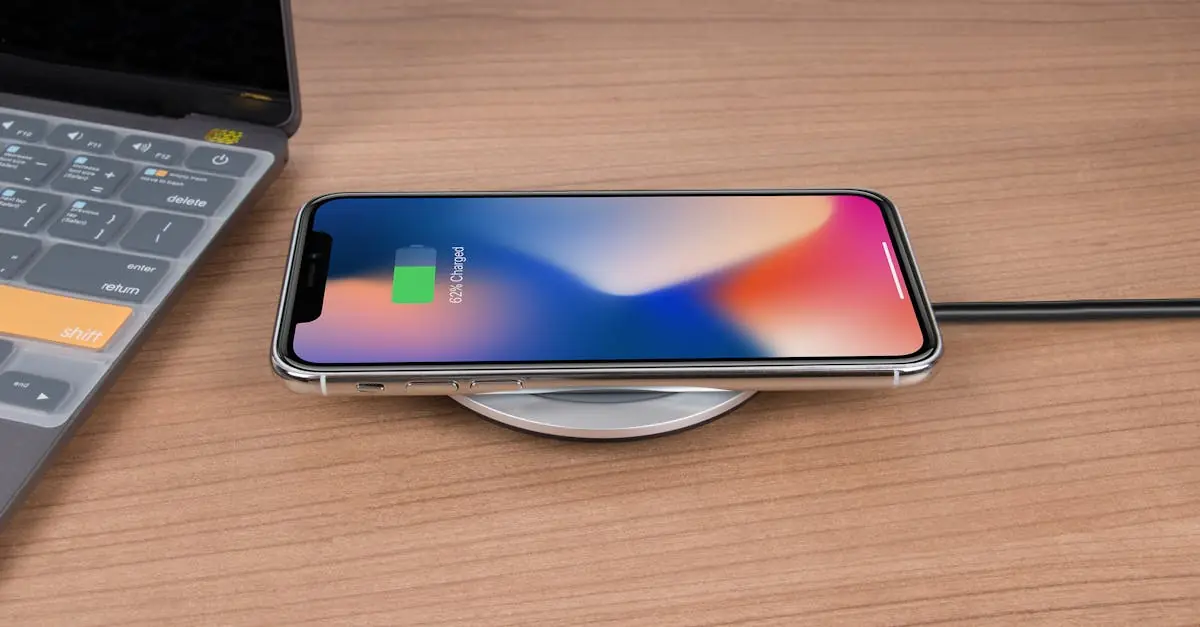Table of Contents
ToggleIn a world where tangled cords and frantic searches for chargers are ancient history, wireless charging pads have emerged as the unsung heroes of modern convenience. Imagine a life where you simply plop your device down and let the magic happen—no more wrestling with cables while muttering under your breath. It’s like having a personal charging assistant who never complains!
Overview of Wireless Charging Pads
Wireless charging pads simplify the charging process for various devices such as smartphones, smartwatches, and earbuds. These pads operate using electromagnetic fields, enabling power transfer without the need for physical connections. Users benefit from the ease of just placing their devices on the pad, initiating charging almost instantly.
Multiple standards exist in the wireless charging domain, with Qi being the most prevalent. This standard allows compatibility across many brands and models, enhancing versatility for users. Additionally, fast charging capabilities are available with certain models, delivering quicker power replenishment compared to traditional chargers.
Features play a significant role in the selection of wireless charging pads. Some pads offer built-in cooling systems, preventing overheating during the charging process. Others provide anti-slip surfaces, ensuring devices stay in place while charging. Designs also vary from sleek and modern models to more rugged versions suited for outdoor use.
The efficiency of wireless charging pads has gained attention. Research indicates that they may achieve approximately 80% energy efficiency with proper alignment. However, factors such as device case thickness and pad placement can influence this efficiency.
A range of pricing options exists, making wireless charging pads accessible to different budgets. Basic models can often be found for as little as $10, while high-end versions may exceed $50 based on additional features and brand reputation. Prioritizing compatibility and desired features remains essential when choosing a wireless charging pad.
Types of Wireless Charging Pads
Wireless charging pads come in various types, catering to different user needs and devices. Understanding these types helps in selecting the right pad.
Standard Charging Pads
Standard charging pads offer basic functionality, primarily designed for regular charging speeds. These pads typically provide a maximum output of 5 watts, suitable for everyday devices such as smartphones and earbuds. Many users appreciate their straightforward design and universal compatibility thanks to the Qi standard. Standard pads usually feature a sleek profile for easy placement and can accommodate multiple devices simultaneously. Pricing for standard charging pads generally starts around $10, making them budget-friendly options for many consumers.
Fast Charging Pads
Fast charging pads significantly enhance charging speeds, often delivering up to 15 watts for compatible devices. Enhanced efficiency reduces the time users spend tethered to traditional charging methods. Models in this category typically feature advanced technology to prevent overheating and maintain optimal performance. Faster charging capabilities benefit devices like the latest smartphones, allowing users to enjoy extended battery life quickly. Prices for fast charging pads can vary, with many high-quality options priced above $30, appealing to those who prioritize quick power replenishment.
Benefits of Wireless Charging Pads
Wireless charging pads offer numerous advantages that enhance user experience. They streamline the process of charging electronic devices, making it more accessible and manageable.
Convenience and Portability
Carrying a wireless charging pad is easy due to its lightweight design. Users can place their devices on the pad without needing to fuss with cords. This simplicity makes wireless charging ideal for public spaces like cafes or offices. Many models support multiple devices simultaneously, reducing the need for additional chargers. The absence of tangled cords creates a neater charging environment. Travelers benefit from portability since these pads can fit into bags without added bulk. Adopting this technology is beneficial for anyone seeking a hassle-free way to charge devices.
Safety Features
Wireless charging pads prioritize user safety with built-in features. Devices often include mechanisms to prevent overheating, which enhances overall reliability. Automatic shut-off functions activate when the device is fully charged or misaligned, preventing energy waste. Many pads also offer foreign object detection, which identifies items that could cause overheating. This feature adds an extra layer of protection against accidents. Additionally, anti-slip surfaces keep devices secure during charging, reducing fall risk. Various brands emphasize safety standards, ensuring peace of mind for users. Prioritizing these features provides a reliable charging experience.
Factors to Consider When Choosing Wireless Charging Pads
Choosing the right wireless charging pad involves assessing specific features and compatibility with devices. A few critical factors stand out when making this decision.
Compatibility with Devices
Compatibility ranks high among the elements to consider. Users must ensure the charging pad supports their devices. Most pads comply with the Qi standard, making them compatible with various smartphones, smartwatches, and earbuds. Additionally, some models cater to specific brands, enhancing performance for particular devices. Checking the power requirements of a device aids in selecting the appropriate charging pad. For example, devices that support fast charging require pads capable of delivering up to 15 watts. Prioritizing compatibility prevents frustration and boosts charging efficiency.
Design and Build Quality
Design and build quality play a significant role in user experience. A charging pad’s aesthetics can complement home or office decor, making it visually appealing. Materials used in construction impact durability and functionality. Lightweight designs facilitate portability, enabling users to move their pads easily. Anti-slip surfaces enhance stability during charging, minimizing the risk of falls. Some models include built-in cooling systems that prevent overheating, ensuring safety during use. Evaluating the overall quality guarantees a blend of style, safety, and performance, leading to a satisfying wireless charging experience.
Popular Wireless Charging Pads on the Market
Numerous wireless charging pads cater to different user needs and preferences. The Anker Wireless Charger offers reliable performance with a sleek design, providing 10 watts of fast charging at an affordable price, typically around $25.
Belkin Boost Up stands out with its robust build quality and efficient charging capabilities, supporting 10 watts for compatible devices and retailing at approximately $40.
Another option, the Samsung Wireless Charger, is specifically designed for Samsung devices, delivering rapid charging of up to 15 watts, priced around $50, making it ideal for Galaxy smartphone users.
The Mophie Wireless Charging Pad combines functionality and style, featuring a premium design that blends with any decor. This model accepts 10 watts of power, available for around $35.
RAVPower provides a budget-friendly solution that supports both 10-watt and 5-watt charging, making it versatile for different devices. It typically costs around $20 and remains a popular choice among users seeking an economical option.
CHOETECH offers a dual charging pad, allowing users to charge two devices simultaneously. Priced around $30, it features 10 watts of fast charging, making it practical for those with multiple devices.
The Spigen Mag Fit brings magnetic alignment into play, delivering efficient charging targeted at compatible devices. It’s available for around $30 and ensures a secure connection for smartphones.
Selecting the right charging pad boils down to compatibility and desired features. These options highlight the diversity and accessibility within the wireless charging market, catering to various budgets and preferences, ultimately enhancing the user experience.
Wireless charging pads represent a significant leap in convenience and efficiency for modern device users. With their ability to eliminate tangled cords and simplify the charging process, these pads enhance everyday life. The variety of options available ensures that there’s a suitable choice for everyone, whether looking for basic functionality or advanced features like fast charging.
Prioritizing compatibility and desired features is crucial for a satisfying experience. By understanding the different types of charging pads on the market, users can make informed decisions that align with their needs. Embracing wireless charging technology not only streamlines the charging process but also contributes to a more organized and efficient lifestyle.








